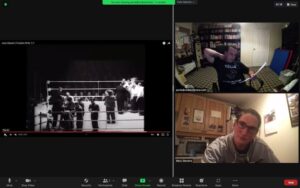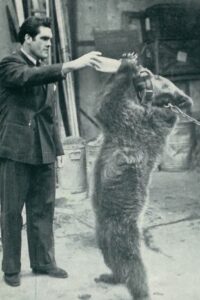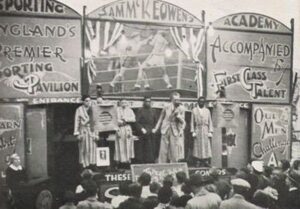The Machine Gun (diary entry)
- jamie03066
- Nov 10, 2021
- 4 min read

09.11.2021 Joey “Machine Gun” Maxim was the light-heavyweight champion in 1952 when Archie Moore was finally given his shot at the title. Tonight, we had a look at Maxim and two interesting bouts he fought prior to finally giving Archie Moore his shot. Born Giuseppe Antonio Berardinelli on 28th March 1922 in Collinwood, Cleveland, Ohio, USA, he earned the ring-name Joey Maxim after the Maxim gun, the world’s first self-acting machine gun. This came from his rapid use of the jab. Standing at 6’1” with a 72½” reach, he was naturally an out-boxer and 61 of his 83 victories were by points or decisions. He fought 116 times, losing 29 and drawing four times. He turned professional in 1940 following a very successful amateur career, including a Golden Gloves title. He then boxed regularly through the war years in exhibition bouts and served as a military police officer at Miami Beach, Florida. He fought 87 times as professional before being given an opportunity to fight for the World Light-Heavyweight Championship. By this time he had won the Northwest Pacific Heavyweight title from Bill Petersen and had also beaten Gus Lesnevitch for the American NBA light-heavyweight title. Joey Maxim versus Freddie Mills Undisputed World Light Heavyweight Championship 24.01.1950 "Fearless" Freddie Mills fought some of his earlier bouts on my grandparents’ circus and fairground booths, and his autobiography has photographs his time revisiting the show many years later once he had made it big. He had been world light-heavyweight champion for two years by this time, having won it on his second attempt against Gus Lesnevitch in 1948. He was also British, European and Em

pire champion. In the lead up to this fight, he left long-time trainer Nat Sellers and decided to train himself. He went into the fight as the favourite with Maxim as a heavy underdog. This would be a classic out-boxer vs slugger match. Mills was fundamentally a brawler who relied on the power he possessed in both fists. There was definitely shades of the swarmer in him to and he was known for his huge heart, which could be seen not only in the microcosm of his bouts but also his willingness (some might say "over-willingness") to take on much heavier opponents. Mills came out strong and was keen to get an early knockout on Maxim, but the out-boxer was on his game and kept out of trouble. The end came in the tenth round when a right sent Mills to the canvas. He made it to one knee but fell sideways and was rushed to his corner for the doctor to examine. It was discovered he had fought for the last four r

ounds with three of his teeth knocked out and one embedded in the gum of his upper jaw. This would be Mills’s 101st and final match. He retired with 77 wins (55 by knockout), 18 losses and six draws. He would be known for his heart and, like many of the great light-heavyweights, many failed attempts at the heavyweight division. Unlike Maxim, he had never succeeded in winning a single heavyweight title. After his retirement as a boxer he tried various other business endeavours. He became a boxing promoter and a trainer. He owned properties, started one of the first Chinese restaurants in England and later turned it into nightclub. He was regularly involved in entertainment, getting parts in various films and, like Jake LaMotta, was noted for his stand-up comedy skills. He even ran his own theatrical agency. His death in 1965 has been a regular subject of investigation. It was originally ruled as a suicide via the modified fairground rife found on him. However, subsequent investigations have put forward alternate theories usually in connection to the mob. He became a known associate of The Kray Twins and he owed money to a crime syndicate. Gangster Meyer Lansky has also been linked by some to his murder. Further claims have been made that he was also the serial killer known as “Jack the Stripper” and this was even the subject of a book. Mills led a colourful life and it is a shame we did not cover him in the 1940s. Perhaps we can discuss him in a special episode on circus and fairground fighters. Joey Maxim vs Ezzard Charles Undisputed World Heavyweight Championship 30.05.1951 Before Ezzard Charles was to lose his world title to Jersey Joe Walcott, as we covered a few lessons back, one of his title defences was against Joey Maxim. After winning the World Light-Heavyweight from Freddie Mills, Maxim won seven straight non-title fights, proving his worth in the heavyweight division. He went in as the 3-1 underdog. There was a pound between them with Charles at 182lbs and Maxim at 181lbs. Both men had fought up and down the light-heavyweight and heavyweight divisions in their career. Interestingly Maxim generally fought more at heavyweight than Charles. The fight was very much of a technical stand-off with Charles displaying better skills and Maxim more displaying his ability to endure than anything else. This appears to have been a similar story throughout their time. It makes for a negative fight. Charles probably scored more on the power punches, being a boxer-puncher, but still couldn’t beat Maxim’s chin. Maxim, on the other hand, was left only with his out-boxing ability that was matched by his opponent. Charles won the bout on a unanimous decision. https://clubbchimera.com/services/













Comments